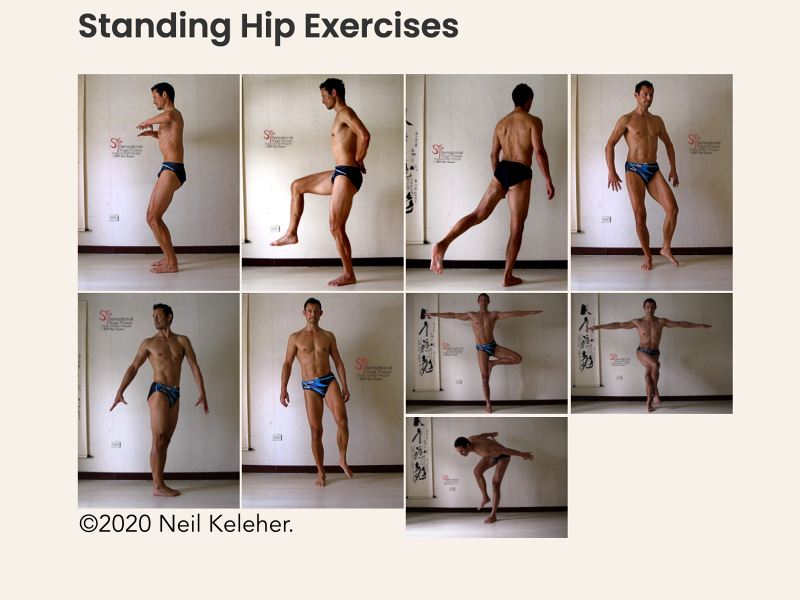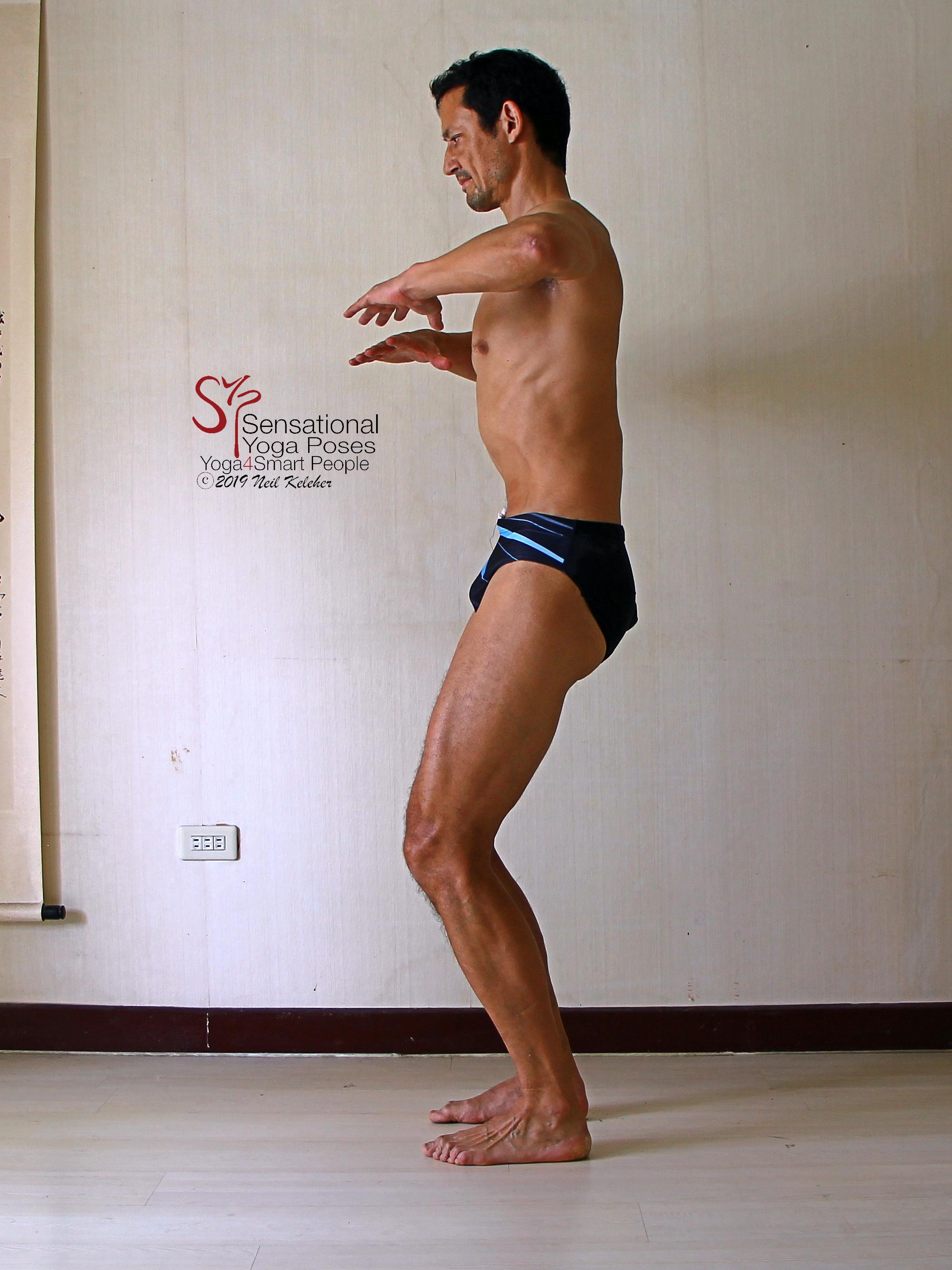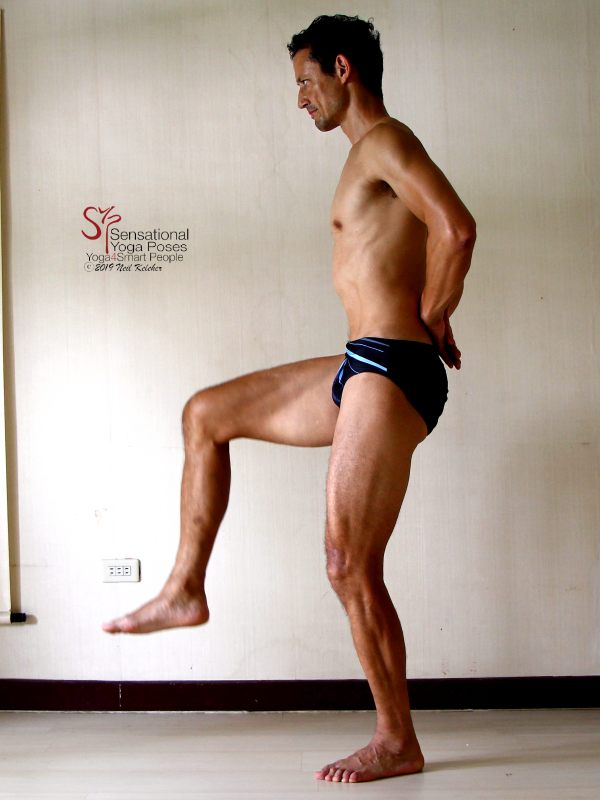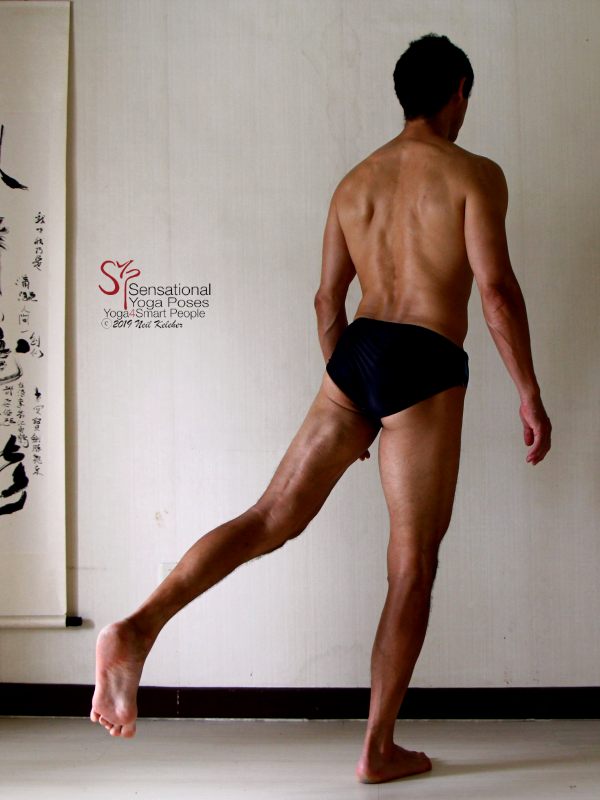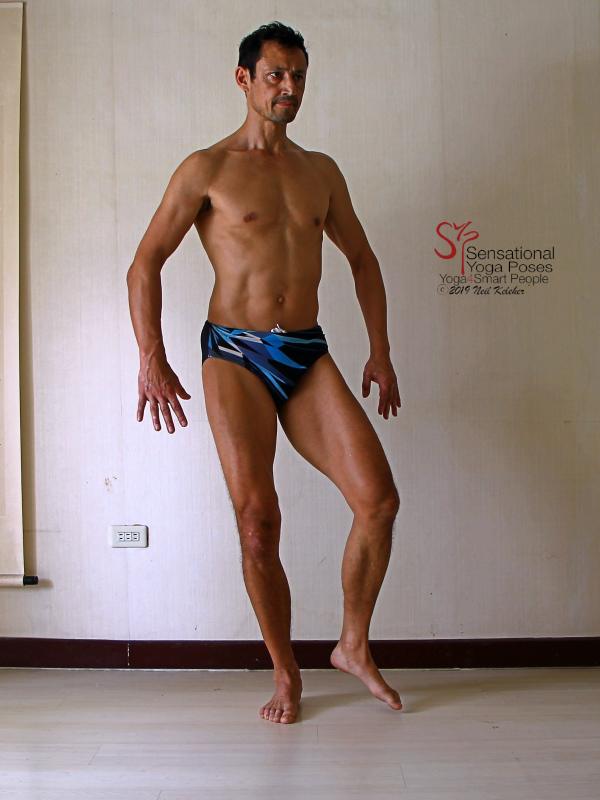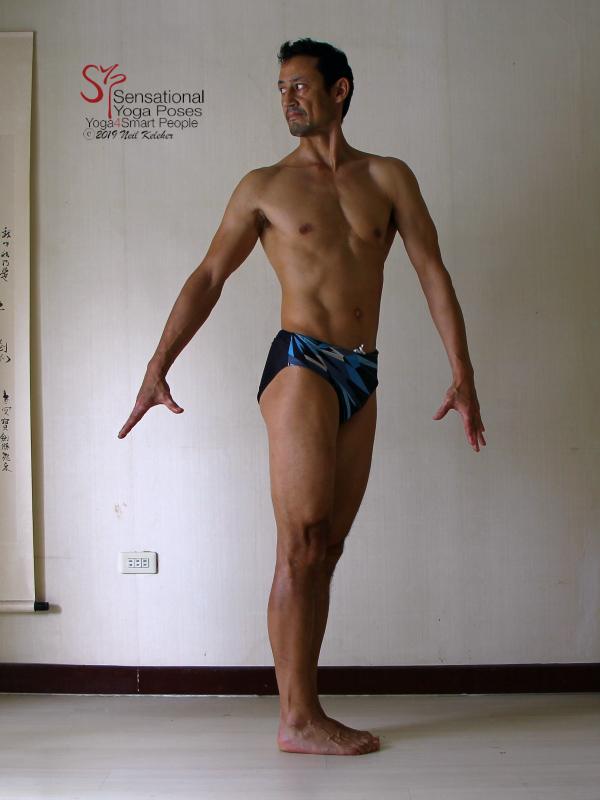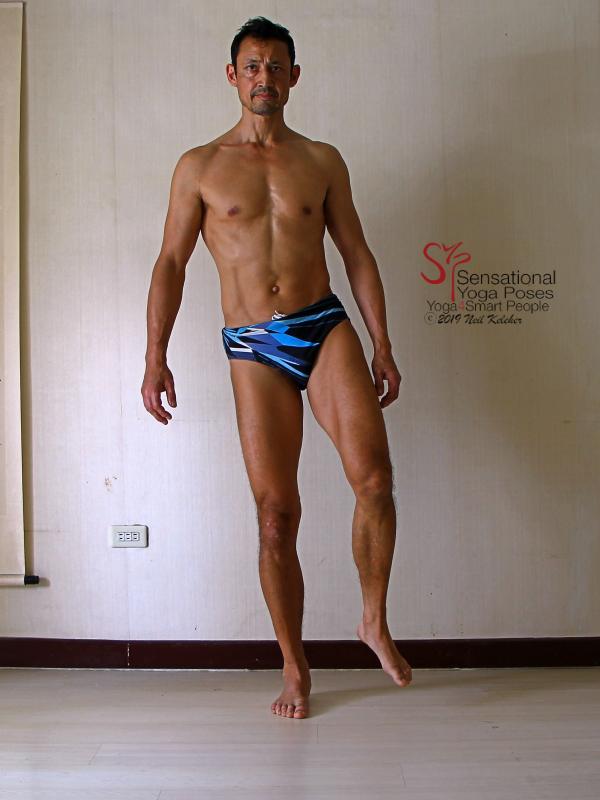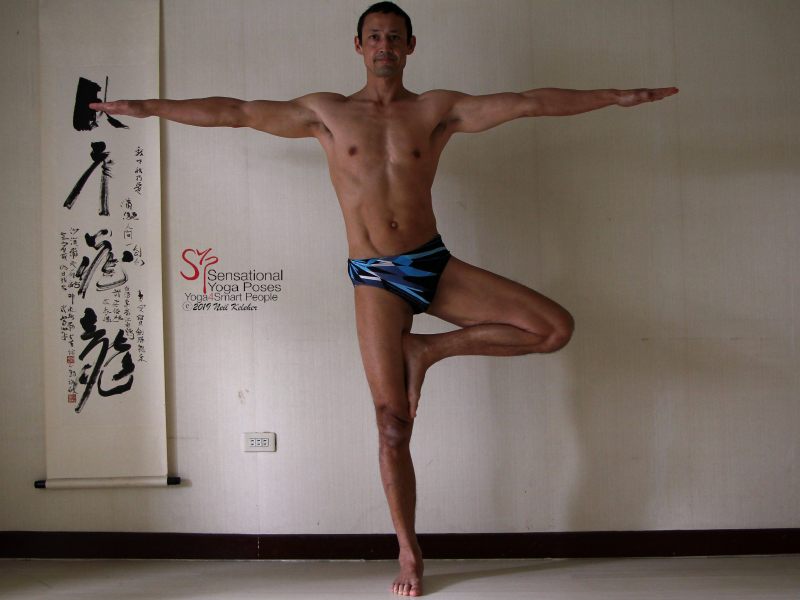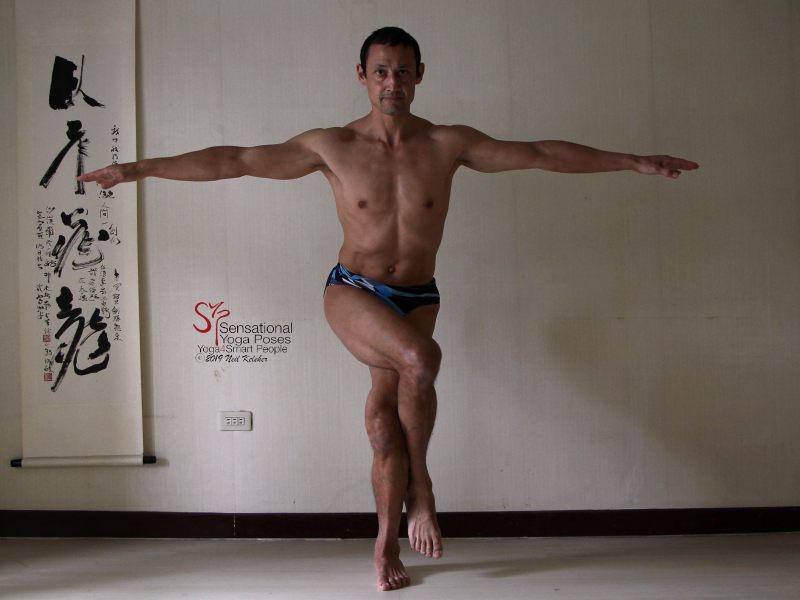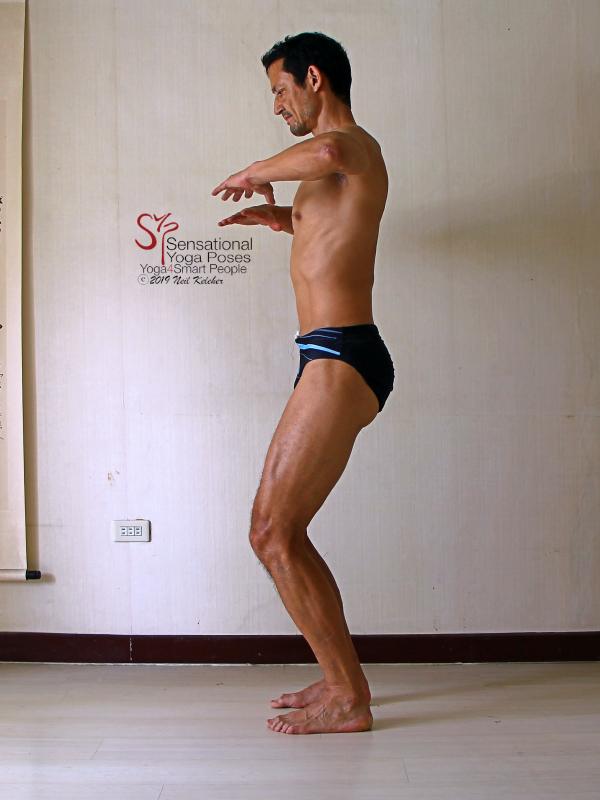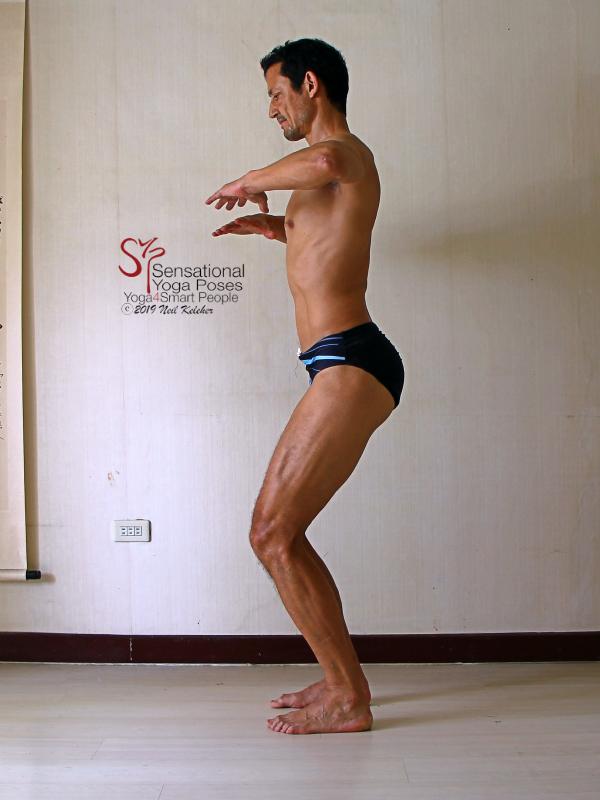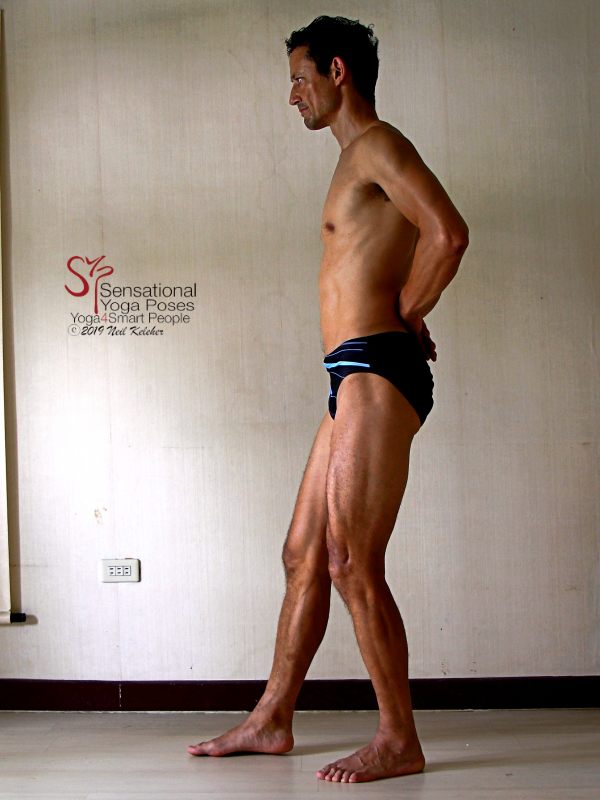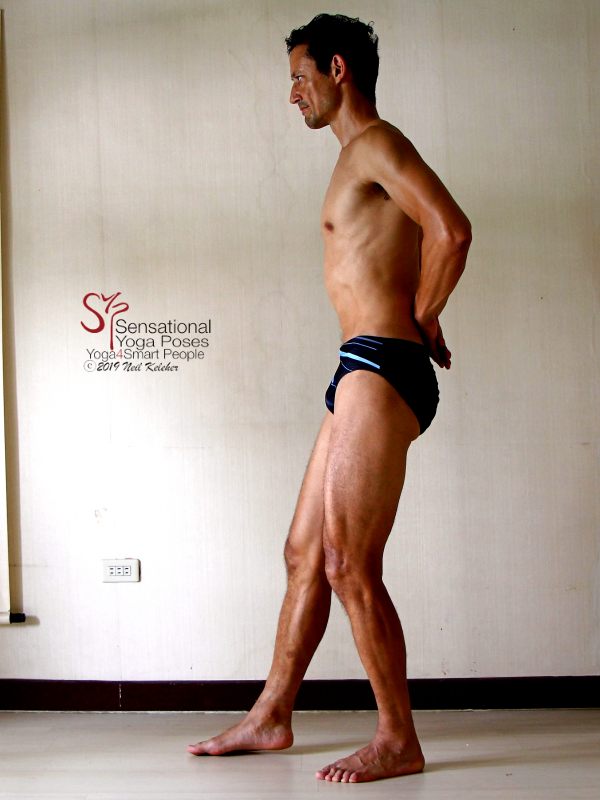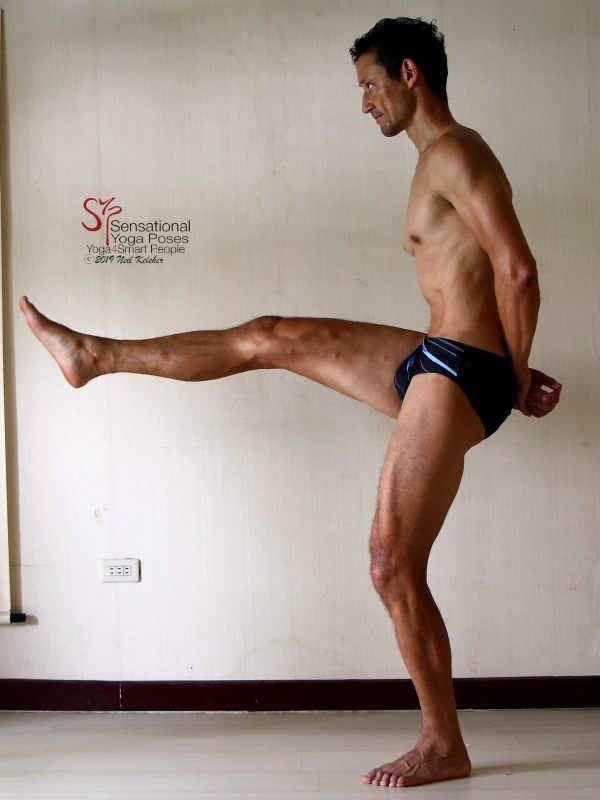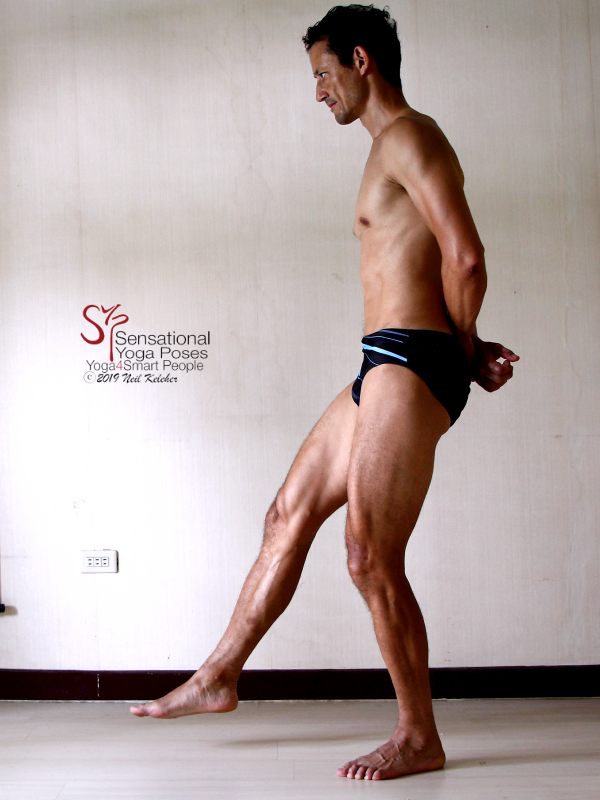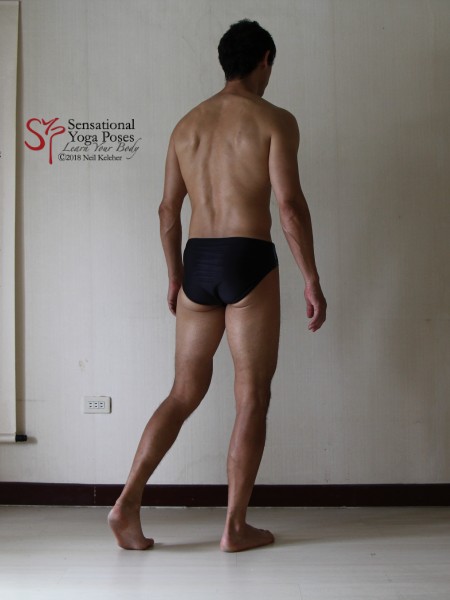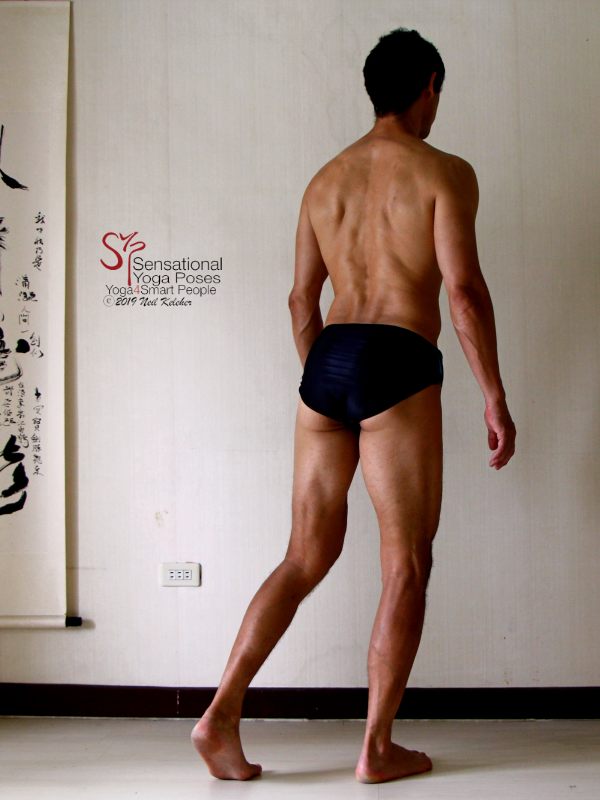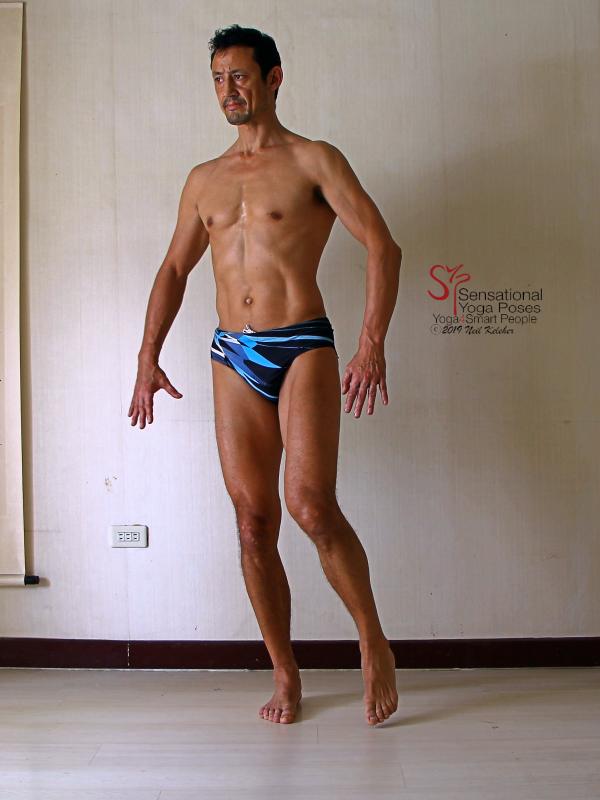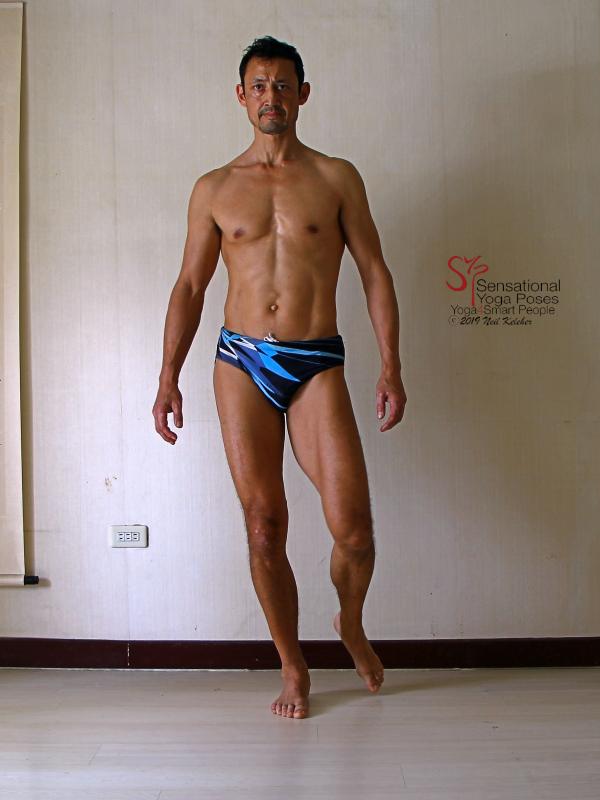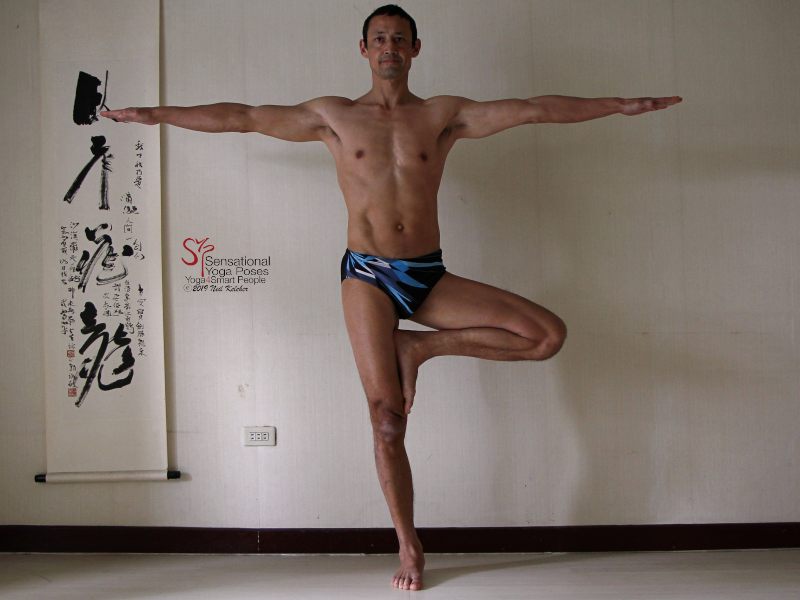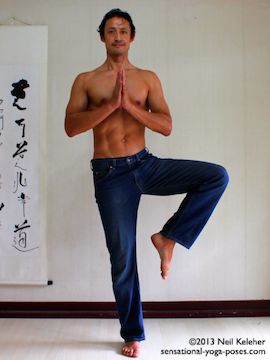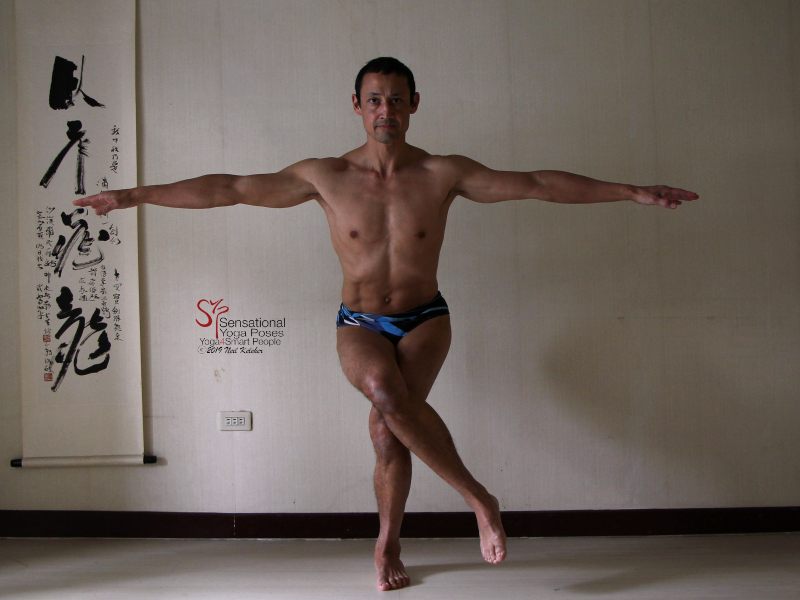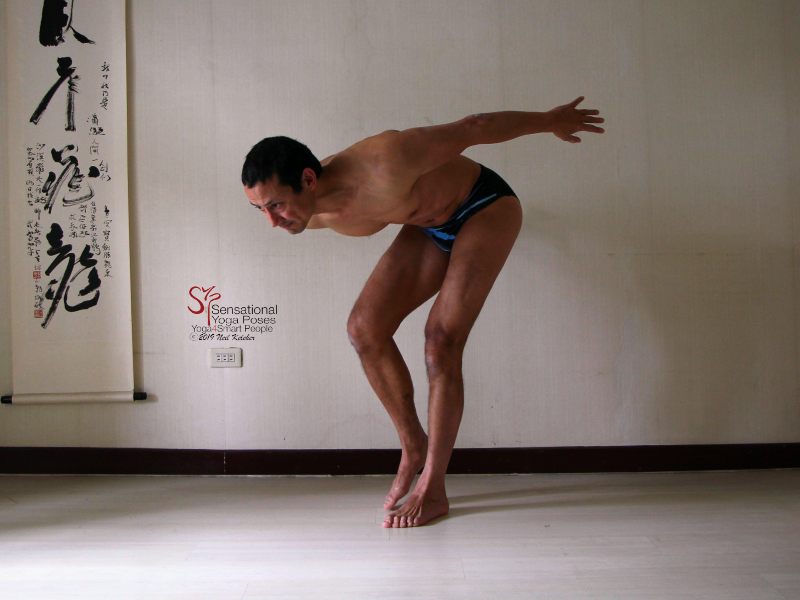Standing Hip Exercises, TOC
The hip joint is where your thigh bone connects to your hip bone. It's a ball and socket joint. It's worked on by lots of different muscles, some of them short and working on only the hip bone and thigh bone, some of them long and connecting between the hip bone and the shin bones.
Then there are other muscles, like the gluteus maximus and piriformis which work on the SI joints as well as the hip joint and even, in the case of the superficial gluteus maximus, the knee joint. Then there are muscles like the psoas major which work on the hip joint and the lumbar vertebral joints.
Rather than worrying about all of these muscles, a simple way to work on your hip joint stability and control is to practice moving and controlling your hip bones relative to your thigh bone.
And so you get better at controlling both hip joints, and so you can spot differences that may be helping cause low back pain, I'd suggest practicing these sort of movements while balancing on one foot.
If you have trouble balancing on one foot, now is your chance to get better at it.
One of the benefits of balancing on one foot is that it may help your low back pain. That's because muscles that act on your feet and ankles can be used to help stabilize your shins against rotation. This in turn gives the long hip muscles a stable foundation.
The long hip muscles are the muscles that attach between your lower leg bones and your hip bone.
With stable shin bones, more specifically, with shins that are stabilized against rotation, these long hip muscles can work to stabilize (or control) the hip bones which in turn gives your lower back muscles a stable foundation from which to help stabilize your lumbar spine.
So one way of stabilizing your hips is to stabilize your lower leg bones.
Another option for stabilizing the shins (and at the same time stabilize the hip bones) is to use the long hip muscles against each other.
This may require activation of the vastus muscles and/or the adductors.
To understand why you can use muscles against each other, and how this can help proprioception, take a look at Muscle Control Principles.
Why is stability so important, or rather, why is giving a set of muscles a stable end point important?
If any set of muscles lack stability, or a fixed endpoint then they or other related muscles will possibly activate in order to create the stability required. If that stability is lacking long term then these muscles will stay contracted long term and that can be uncomfortable.
So one reason for creating stability is that it makes it easier for some muscles to relax when they need to. It's the equivalent of standing on ice or rather, not standing on ice.
How easy is it to relax when you are standing on ice? Not very. You will probably be tense to prevent your feet from sliding away from each other. Stand on a surface that provides friction, and thus stability and it's so much easier to relax if you choose.
Another reason that stability is so important is that it makes it easier to activate and control muscles, particularly if you've stabilized one of the endpoints to which that muscle attaches. So for example, stabilizing the shins makes it easier to use the long hip muscles to stabilize and/or control the hip bones and thus the hip joints.
In the exercises that follow, the idea is to move your hips in specific directions. To enable you to do this easily, focus on making your feet, ankles and shins stable.
Since the long hip muscles attach to the top of the inside and outside of the shins, just below the knees, I'd suggest you focus on keeping this part of the knee, the top of your shins, stable.
Focus on preventing the tops of your shin from rotating. (Or depending on the action you are doing with your hips, control the rotation.)
To make this easier, stand with your weight shifted forwards so that you can easily press your forefoot into the floor. Focusing on pressing the inner and outer edge of your forefoot downwards to varying degrees.
Depending on the action you are doing you may find it helpful to press slightly more into the inner edge of the forefoot or slightly more into the outer edge.
One of the most basic Standing Hip Exercises you can do is to practice tilting your pelvis forwards and backwards.
When teaching this I tend to have students focus on lifting and lowering the sacrum since it forms the base of the spine. You could also focus on your pubic bone.
When teaching this to beginners, particularly those who've never been taught hip awareness, I have them standing on both feet with knees comfortably bent. Once they get the exercise while standing on both feet they can then work at practicing it while balancing on one foot.
For all of these actions and exercises, focus on repeating any movements slowly and smoothly.
Lifting the Sacrum
While standing on both feet with knees comfortably bent, and starting with pelvis neutral (somewhere between fulling tilted forwards and fully tilted backwards):
- Slowly lift your sacrum so that your pelvis tilts forwards.
- Feel your lumbar spinal erectors activate as your lumbar spine bends backwards
- Relax (return to neutral) and repeat.
Focus on moving slowly and smoothly.
In the second picture I've lifted my sacrum to increase lumbar lordosis or "back bend".
Dropping the Sacrum
Next focus on dropping your sacrum:
- Move your sacrum downwards so that your pelvis rolls back.
- Feel the back of your lumbar spine flattening or "opening".
- Relax and return to the neutral position and then repeat.
The funny hand position is so that you can see the change in pelvic tilt a little easier! In the second picture I've dropped my sacrum to decrease lumbar lordosis.
When dropping your sacrum, you could lead the action by pulling inwards on your lower belly. This can help in stabilizing the SI joints which in turn help to unify the two hips bones and the sacrum.
In this case you are using the lower band of your transverse abdominis to add tension to the thoracolumbar composite (which is part of the thoracolumbar fascia).
Another option is to use your gluteus maximus. So that you get the superficial fibers of this muscle to activate, try creating a downwards pull on your PSIC, the posterior point of the iliac crest, near where the iliac crest meets the sacrum.
Pelvic Tilting while Balancing On One Foot
Once you've gotten used to both movements and can do them slowly and smoothly without having to think about how to do them, you can practice moving between the two positions, sacrum lifted and sacrum dropped, while standing on one leg.
Try positioning your standing foot so that it is turned out a comfortable amount and stand with the knee of your standing-leg comfortably bent.
Shift your weight forwards so that you can use your forefoot to help keep the top of your shin stable.
Vary the sideways tilt of your pelvis (left or right tilt) so that both sides of your lumbar spine feels comfortable
A bonus hip stability exercise you can do once you are used to controlling the forward/backward tilt of your pelvis is the standing hip flex. (The hip extension follows!)
A hip flex is when you bent your hip forwards. In this case you'll be lifting the knee of your lifted leg towards your chest to flex your hip. But you'll lead the action by first dropping your sacrum and pulling up on your pubic bone.
Stand with your weight on one foot, with the foot turned out and knee slightly bent. Shift your weight forwards so that your forefoot presses down.
- Drop your sacrum. Pull up on your pubic bone (or better yet, your ASICs).
- Slowly and smoothly lift your knee while maintaining a flat lumbar spine.
- Slowly lower and repeat three to five times. Then switch sides.
To maintain the flat lumbar spine, focus on controlling your standing leg hip bone.
For extra fun you could also straighten the leg, or you could lift the leg with the knee straight.
This will require extra hip stability on both your standing leg side and your lifted leg side.
Note that in the above picture I'm lifting my leg rather high. To begin with you might want to lift your leg just a slight amount.
So in this picture, my leg isn't quite as high.
To counterpose the hip flex you can now practice extending your hip.
Counterposes are poses that you use to balance a particular action. So in this case you will be balancing hip flexion by also doing hip extension.
Hip extension is when you bent your hip rearwards. In this case you'll be lifting your lifted leg rearwards with the knee straight. But you'll lead the action by first lifting your sacrum and bending your lumbar spine backwards.
Focus on feeling your lumbar spinal erectors activating when lifting your sacrum.
Stand with your weight on one foot, with the foot turned out and knee slightly bent. Shift your weight forwards so that your forefoot presses down. Position the other leg backwards, with toes touching the floor behind you.
- Lift your sacrum. Pull up on your pubic bone (or better yet, your ASICs). Feel your lumbar spinal erectors activate.
- Slowly lift your leg rearwards. Try to keep the knee pointing downwards.
- Slowly lower and repeat three to five times. Then switch sides.
For the next exercise, again start by standing on both feet. Knees can be bent or straight. Keep weight even on both feet and turn your hips to the right. Return to center. Repeat a few times to the same side, then practice turning your hips to the left.
Next, while standing on your right leg, practice turning your hips right and then left.
Practice moving slowly and smoothly. Repeat while standing on the left leg.
As a bonus exercise you can do a standing spinal twist. For this standing hip exercise, stand with your feet parallel or slightly turned out. Knees are straight.
Turn your hips to the right relative to your feet. Then turn your ribcage to the right relative to your ribcage. Likewise turn your head relative to your ribcage.
To deepen the twist:
- Internally rotate the right hip and externally rotate the left hip so that your hips turn deeper to the right.
- Lengthen your spine
- Use your hip rotators and your spinal lengthening muscles to deepen the twist.
- Relax and hold the twist, then repeat the above actions a few more times before turning to the front and changing sides.
When turning your hips, remember to keep the tops of your shins stable.
For the next exercise stand on one leg with the knee slightly bent or straight. Slowly lift the lifted leg hip. Try to use the hip of the standing leg. Then pull the lifted leg hip down, again using the standing leg hip.
In both cases, lifting or lowering the hip, I'm trying to use the hip muscles of my standing leg.
Sticking with the hip lift action, another pose that you can practice it in is tree pose. Focus on lifting (and then lowering) the lifted leg hip.
Additionally, you could pull the lifted foot away from the leg after lifting the hip.
Getting into eagle pose, you can start with the lifted leg thigh on top of your supporting leg. Lift the lifted leg hip to make it easier to bring your top leg foot against your bottom leg shin.
Be careful with this hip stabilization exercise. If you find it's too much on your lower back, leave it out, or place your hands on a chair while bent forwards. Do focus on making your spine feel long in this pose. You may find it helps to draw in your belly so that you are using your transverse abdominis to help stabilize your lumbar spine.
From there, with weight on one leg, focus on lifting and lowering the lifted leg hip.
Perhaps one of the most important things that you can do once you are comfortable with these exercises is to self adjust.
For example, when turning your pelvis left and right, adjust the sideways tilt of your pelvis, or the front/back tilt of your pelvis. You can do this at any point of the movement. For example, standing on your right leg and turning your hips to the right, you may find it helps to lift your left hip. Then when you turn fully to the left it helps to drop your left hip. (The opposite may also be true).
The point is that even when you get comfortable with the exercises, don't do them absentmindedly. Instead, notice how your foot, your shin, your hip and your lumbar spine feels and adjust so that you can feel all of these parts, and adjust so that they are comfortable.
If you aren't sure about where the most comfortable position is, or you aren't sure whether you can feel a part of your body or not, then repeat the adjustment action.
For example, turning your hips to the right while standing on your right leg, lift and lower your left hip slight amounts repeatedly (but slowly and smoothly) to experience both positions and so you can then decide which position feels best.
More on Muscle Control and Feeling Your body
If you are interested in learning more about hip and leg control, say learning to directly control various muscles of the hips and legs, including the long hip muscles, I'd suggest the driving lessons for your body courses. If you are really new to the idea of muscle control then you may be better of starting with 5 Beginners Yoga Routines. Another option for hip control is the "hip crease, butt and inner thigh" series. Yet another option is the series of courses you can see under driving lessons for your body
Note that muscle control isn't just about "controlling muscles". Muscle control is what can help you to feel your body.
You can check out any of the above programs one the driving lessons for your body page.
Published: 2015 05 17
Updated: 2023 03 20
